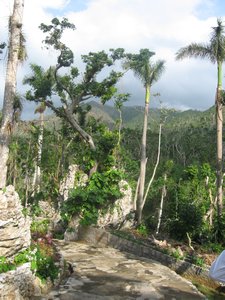Advertisement
Published: April 8th 2009

 The pathways and damaged trees
The pathways and damaged trees
At the Soroa Orchideario six months after two severe hurricanes passed through Finally, after ten years of visiting Cuba, I was on my way to see the strange and unusual landscape of the Vinales valley in Pinar del Rio Province - a land of isolated cylindrical steep-sided limestone hills, riddled with caves, which tower above the surrounding tobacco growing farmland with its bright red soil. These distinctive formations are the same as those seen in ancient Chinese watercolours of the Li valley in Southern China. Early in the morning we headed west along the autopiste which links Havana to the province of Pinar del Rio, crossing miles of flat scrubby land with occasional patches of sugarcane, sisal, poor pasture and even a few small rice fields; the main feature was the huge water reservoirs, supplying Havana, which covered much of this landscape. Passing signs to a designated biosphere reserve at Las Terrazas, we turned north into the hilly limestone area around Soroa and the site of our first destination - the Orchideario a botanical garden with over 7000 species of orchids. It had been hard hit by two hurricanes in eight days the previous August (2008) and trees were downed in great swathes, others stripped of their leaves and branches and the
gardens had been forced to close for two months to clear and replant so we wondered what would be there to see just six months later. Bu nature makes a quick comeback in the Tropics and the amount of new growth was just amazing. Admission fees at the gate are 3 convertible pesos and an extra one if you are using a camera. Our guide was a graduate botanist with excellent English skills. Narrow stone pathways and steps led us between jutting outcrops of honeycomb limestone, pitted with solution holes, and every little fragment of soil has been planted with orchids or other flowering plants, such as red flowering ginger, huge crotons and ficus - all plants we in the North are more accustomed to seeing as house plants in pots. The orchids showed incredible variety and many are extremely rare. The area is quite remote and peaceful and there are also many birds to be seen, a relaxing place to visit.
The bus retraced our steps to the autopiste and we headed further west to the turnoff for the Valley of Vinales. On this road we soon got into the mountains of the Sierra de los Organos, separated
by flat farmlands with soil so red it seemed to glow and, just 4 km from the town of Vinales, there was a lookout which gave us our first good panoramic look at the mogotes, those rare and unusual limestone hills. Driving on through the town it seemed that nearly every house had a sign advertising one or two rooms for rent, for this is a great destination for hikers. Just outside the town we stopped at the Hotel la Ermita for lunch and another great panoramic view. Driving on further we saw many oxen being used as draft animals to plough and pull carts, mechanisation has yet to arrive in this remote district. There are several tourist caves in the area and the one we visited had a pathway leading to an underground river, where boats took us through some great formations. It is not perfectly illuminated and it is a good plan to take a flashlight with you. From this location we moved on to another landmark touted by Cuban tourism - this is the huge and garish Mural de la Prehistoria on a limestone cliff, commissioned by Fidel to show the evolution of Socialist Man. It was
painted by local farmers who had to be lowered down the cliff on ropes, and it looks like it! But - if you turn your back on it you are rewarded with another great mogote view to stay with you on the long drive back to Havana.
Advertisement
Tot: 0.101s; Tpl: 0.01s; cc: 10; qc: 26; dbt: 0.0808s; 1; m:domysql w:travelblog (10.17.0.13); sld: 1;
; mem: 1.1mb

 The pathways and damaged trees
The pathways and damaged trees